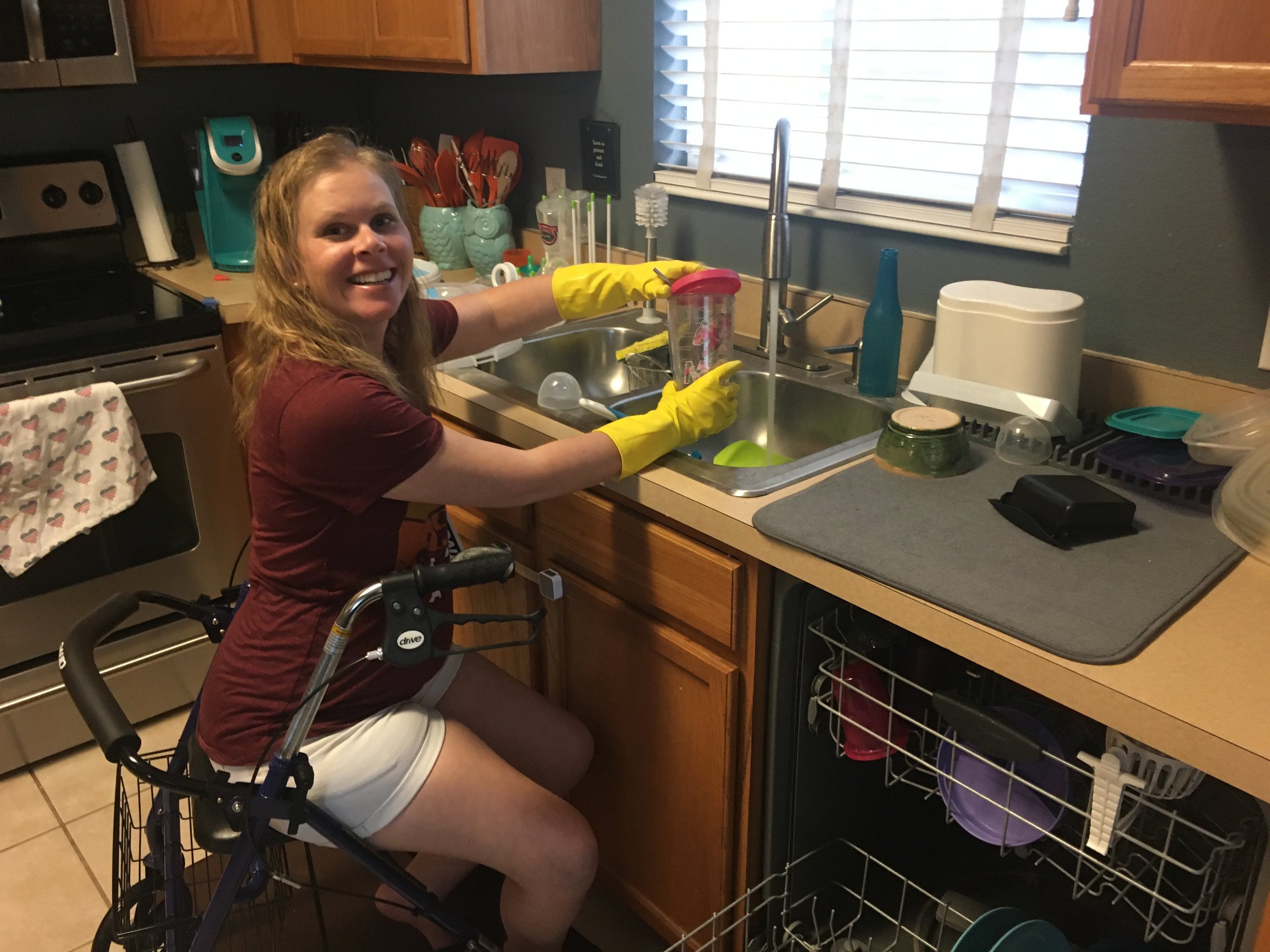Chloe Ann’s Birth: AFE Survival
Written by Cathy Garrett
Note - Below is an abbreviated version of Cathy Garrett’s birth experience of her second child, Chloe Anne. It recounts her and her daughter’s survival of an amniotic fluid embolism (AFE). It shares a detailed account of extreme birth trauma. We share a shortened version of her account here to educate and inform. If you want to read the extended version of her story or check out her podcast with her sister Christina, please visit thetwinkychronicles.com.
On September 18th, only 1 day after my estimated due date, I went into labor. Later that evening, we went to the hospital and I spent most of the night in triage. The next morning, I received an epidural and decided to take a nap.
After a few hours my husband, Eli, said I suddenly woke up and yelled, “My heart is racing!” He then looked at the monitors which were not reading anything. He didn’t think much of it, because monitors slip all the time; especially while in labor. Next, he went to get my nurse, Kristi. She happened to be at the nurse’s station right outside my room and readily available.
As he and Kristi walked back into the room my husband saw my eyes roll back into my head and I slumped over.
Kristi said she grabbed my wrist (to check for a pulse) and pulled the blood pressure cuff off in one swift motion. When she did not find a pulse, she grabbed my shoulders, started shaking me, and yelled my name several times. She then hit the staff assist button which calls the NICU and the L&D teams. When my pulse didn’t return after 6 minutes, I was prepped for an emergency c-section and a “Code Blue” was called because my team would need more help. Several members of the code team had trouble finding my room, because it is a rarity that codes are called on the L&D floor. At this point my husband and my doula, Brittany, were rushed out of the room as several nurses and doctors rushed in.
My daughter, Chloe Anne, did have to be resuscitated and intubated, but was in the NICU for only 4 days and my husband was able to meet her in the hallway on her way to the NICU. She also sustained a small cut on the back of her right shoulder but only needed steri strips for it to heal!
Then they started working on me.
The hospital’s OB (my OB was in a cesarean) was trying to get my uterus to contract and stop bleeding. I had gone into disseminated intravascular coagulation (DIC), which medical professionals call “death is coming”. This where your body is bleeding from every orifice and throws blood clots at the same time. After a 30 minute code and a lot of shocks, the doctors stabilized me, packed my uterus and rushed me to an operating room. At this point, my OB met the code team in the OR and made the decision to do a hysterectomy (The same OB had a patient pass away from the same condition a few months prior and was not going to take any chances!).
While the OB team was performing that surgery, the Cardiac Team was performing a sternotomy simultaneously to determine what was going on with my heart and lungs. I had a hemopneumothorax, which means my chest was filled with air and blood, and when my lung collapsed it compressed my heart. I also had a blood clot in my lung which had to be removed. I coded several more times in the OR and would need to be placed on Extracorporeal membrane oxygenation (ECMO). ECMO for adults has only been around for about 5-10 years, but saved my life because my heart and lungs were not working properly. I had 3 broken ribs from CPR and my sternum is now held together by wires. Over the course of the next week I would need 4 more surgeries and would eventually need over a hundred units of blood and blood products. I was in a coma and on life support for a total of 9 days.
I had a hematoma on the right side of my brain, blood clots in my right hand, in my brain which caused a stroke, and in the veins leading to my kidneys and legs which caused my kidneys to shut down and cut off blood supply to my legs. The doctors even talked about a double amputation and kidney transplant, but thankfully both were not needed. Although I’m lucky enough to have a perfect donor because I am an identical twin!
My entire family traveled down to see me along with several friends. Many of them said they only recognized me by the color of my eyes. My body had endured so much trauma, I was full of fluid, double my size, and my hair was a matted mess.
When I woke up I didn’t remember delivering my baby or even being pregnant. It was a monumental amount to process, not only had I been pregnant, I delivered a baby, and suffered a life threatening complication. It would take about 6 months to fully process how sick I truly am. Since I was still intubated when I came too, I couldn’t ask questions and did not have the dexterity to write or text. I remember trying to string together sentences and becoming so frustrated. I do know a little bit of sign language and my husband would translate for me. Now looking back, it was quite comical when he was not there and the nurses tried to guess what I was saying.
A few days after I woke up, I failed multiple breathing tests and was told I would need a trach. The surgery was scheduled and my husband signed the consent. I was devastated. I did not want another scar. Especially such a visible scar. My incredibly kind ICU nurse happened to have had surgery and showed me her trach scar. It was visible, but not really that bad. I can’t fully remember because ICU delirium is very real, but I think it was that same nurse who advocated for me to the night doctor and explained she thought I was doing well enough to come off the vent. The doctor called my husband to ask if she could try to extubate me. She and the nurse thought I was doing well enough to at least try and explained if I could not hold my oxygen levels they would do a bedside trach. He said of course and I was extubated a few hours later! I was incredibly overjoyed! I’ll never forget when my amazing nurse Hannah ran into the to give me the biggest hug!!!
After being in ICU for 2 weeks, I was transferred to the cardiac step down unit then on to inpatient rehab. I remember arguing with my doctor that I did not need to go to rehab because I wanted to go home. My husband is typically a man of few words. He looked at the doctor and said, “She’s going!” I had severe weakness, especially on my right side. I also had a drop foot, which is difficulty lifting the front part of the foot. I conceded, begrudgingly. At rehab I would relearn how to walk, write, organize my pills, swallow properly, and regain strength. Doctors initially thought I would be in the hospital for 6-8 months.
When I was discharged on Oct 18th, only 1 month after I went into labor, my wonderful friend Dixie decided to throw me a party! It truly was the best welcome home!!! Since being home I have had to do several rounds of in-home speech, occupational, and physical therapy, and I am currently entering my second year of outpatient therapy trying to be cleared to drive again. I also still have weakness and atrophy on my ride side; especially in my leg. Also, the right side of my heart is still enlarged, but my cardiologist believes that with more time it will heal. The body is truly amazing in the way it heals itself!
Due to the blood thinners I was on, I was not able to nurse my baby, which was devastating to me. I cried for an hour straight once I made the decision to stop trying to relactate. Obviously, I am immensely grateful to the many friends, family, and even strangers who came forward to donate milk to our little girl but it was hard. It was so hard to bond with her. I was absent for the first month of her life.
I felt like when I got home I was so confused and didn’t know how to care for this little person who I was barely strong enough to pick up.
Bonding with my first daughter was instantaneous and amazing. After being away from my second for an entire 2 weeks and I didn’t come home until 1 month, bonding with her was long, hard, and exhausting in its own right. It took 9 long months and I didn’t even realize it was common after birth trauma until about 3 or 4 months in. Thankfully now our bond is amazing, beautiful, and we have this extra shared experience!
This experience has been nothing like anything I have ever experienced in my entire life or seen others for that matter. It damaged my body in so, so many ways- physically and mentally. It has been unimaginably hard, but has birthed in me a strength and determination to meet my therapy goals. I certainly would not wish this on absolutely anyone and, in some regards I hate it, but I’m also thankful it gave me my daughter and I am a completely different person now. I used to be a doormat and allow people to walk all over me.
I have learned to use my voice in so many new ways and I am loving learning about this “new person”!
My daughter and I survived an amniotic fluid embolism which occurs only in approximately 1 in 40,000 births. I was given only a 1 % chance of survival and the survival rate of AFE is only around 20-40% for mothers and 65% for neonates still in utero. For more information, please visit www.afesupport.org. I have also started a podcast to share my story, and give others a space to do the same.




